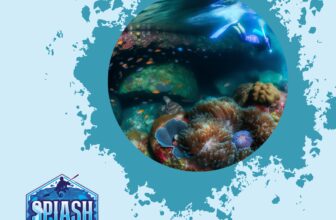
Embarking on a snorkeling adventure is like stepping into another world, alive with vibrant colors and fascinating creatures. But if you're new to the snorkeling scene, identifying the marine life you encounter might seem daunting. This guide is here to demystify that experience and help you recognize popular species you'll see on your underwater adventures.
Understanding Marine Life Identification for Snorkelers
Marine life identification snorkeling is about recognizing and learning the names of the fish, coral, and other sea creatures you encounter during your underwater adventures. Think of it like a game of “spot-the-difference,” but instead of comparing pictures, you’re observing the wondrous variety of life beneath the waves. By learning to identify marine species, your snorkeling trips will not only be more enjoyable but also educational.
Knowing who’s who in the underwater world makes snorkeling feel like you’re visiting old friends rather than just floating above a blur of colors. And here’s why it’s worth your while: being able to identify marine life enriches your experience. It encourages a deeper connection with the environment and enhances your stories to share afterward. Imagine telling a friend about how you swam above a school of shimmering blue tangs instead of just “some pretty fish.”
Understanding marine species also has practical benefits. It’s crucial to know which critters are safe to observe closely and which ones require a safe distance—like keeping an eye out for stonefish or lionfish, which can be decidedly less friendly than their benign appearances suggest. This knowledge keeps you and the creatures safe, ensuring your encounters remain respectful and leave no harm to either party.
In short, mastering marine life identification gives you a richer, safer, and more engaging peek into the ocean’s fantastic realm. As you start on this rewarding journey, you’ll discover that the underwater world is not just about pretty sights, but about understanding a fragile ecosystem where every creature has its role.
The Basics of Species Guides and Their Use
When you're new to snorkeling, a species guide can be your best friend. Think of it as a cheat sheet for the underwater world. These guides are packed with pictures and facts about the most common marine life you'll encounter. By using a guide, you can turn your snorkeling trip into a treasure hunt.
So, how do you make the most of a species guide? First, get familiar with it before you hit the water. Flip through the pages or scan the app on your device. Look for key features in the pictures, like the colors and shapes of fish or any distinctive markings. When you're actually snorkeling, try to match what you see underwater to the images in your mind. This process helps you become a quicker spotter and makes identification more natural over time.
When out of the water, jot down or mentally note the creatures you're curious about, then use the guide to confirm what you saw. Over time, you'll start recognizing species by sight, almost like you're greeting old friends.
In short, let a species guide be your mentor—when you know what you're looking at, every encounter with marine life becomes more meaningful and gives your snorkeling adventure that extra spark.
Exploring the Rich Biodiversity of Coral Reefs
Coral reefs are the bustling cities of the ocean, teeming with life and color. These underwater ecosystems play a crucial role in supporting marine biodiversity, acting as nurseries for countless species, and providing food and shelter to many others. When you snorkel around coral reefs, you'll enter a vibrant world where every nook and cranny hides a new wonder to discover.
As you glide over these sandy floors and rocky formations, you'll likely encounter some of the most iconic residents of the reef. Parrotfish are particularly common, known for their bright hues and the crunching sound they make as they bite into coral, helping to maintain the reef's health. Their dazzling colors and playful demeanor make them a delightful sight for snorkelers.
Clownfish, popularized by their animated fame, are another must-see. These tiny, orange-striped fish are often found darting in and out of their sea anemone homes, where they find protection from predators thanks to a special mucus on their skin that keeps them safe from the anemone's sting. Spotting a clownfish is like finding a little treasure amid the coral's kaleidoscope.
Then there are the serene sea turtles. Graceful and seemingly unbothered by their human observers, these gentle reptiles glide through the water with an almost Zen-like tranquility. Watching a sea turtle soar through the ocean is a mesmerizing experience, reminding us of the reef's timeless beauty.
These encounters are just the beginning. The vast array of species that call coral reefs home can astound even the most seasoned snorkeler. Keep your eyes open for the swirling schools of blue tangs or the elusive octopus, expertly camouflaging against the coral backdrop. With each dive, you'll learn a bit more about this magical marine metropolis.
Popular Marine Wildlife in Tropical Waters
Tropical waters are a treasure trove of diverse marine life, bustling with color and activity. As a beginner snorkeler, you’ll be astounded by the variety of species you can encounter just beneath the surface. Some of the most iconic creatures you’ll find in these warm, clear waters include the vibrant angelfish, sleek moray eels, and graceful stingrays.
Angelfish: The Colorful Celebrities
Angelfish are a visual delight, with bright colors and distinct patterns that make them easy to spot. These social butterflies of the reef usually swim in small groups. Look for their thin, laterally compressed bodies gliding near the corals. Angelfish have long, pointed fins which add to their elegant appearance, making them stand out among their underwater neighbors.
Moray Eels: The Guardians of the Crevices
Moray eels might look intimidating due to their serpentine bodies and sharp teeth, but they aren’t aggressive if left undisturbed. Typically hiding in rock and coral crevices, these eels can be spotted by their heads peeking out as they wait for prey. Their skin often boasts intricate patterns that can help distinguish between species. Approach with care and observe their mesmerizing movements from a respectful distance.
Stingrays: The Gentle Gliders
Stingrays are as serene as they are beautiful. With their flat bodies and long, whiplike tails, they glide effortlessly along the sandy ocean floor or hover above reefs. While they might seem intimidating due to their size, stingrays are generally gentle creatures. Look for the unmistakable flapping of their pectoral fins, resembling wings as they swim.
By familiarizing yourself with these key characteristics, you can confidently identify some of the most popular and fascinating residents of tropical waters. Keeping your eyes open and moving slowly will enhance your chances of enjoying these magnificent sea creatures up close during your snorkeling excursions.
Marine Life Chances on Snorkeling Tours
When you sign up for a snorkeling tour, you're not just paying for the gear and the boat ride—you're investing in a curated experience. These tours often take you to prime snorkeling spots where the chances of encountering diverse marine life are significantly higher.
What to Expect on Guided Tours
Guided tours are designed to offer a glimpse into the underwater world’s hidden treasures. Whether it's a vibrant coral reef or a tranquil sandy bay, these tours often mean access to well-preserved locations where local wildlife flourishes. Here’s what you might experience:
- Coral Gardens: Spot fish congregating around majestic coral formations.
- Seagrass Meadows: Watch sea turtles gracefully gliding through their habitat.
- Unique Marine Residents: Look for clownfish darting among anemones and schools of angelfish weaving through rock formations.
Expertise of Guides
One major advantage of going on guided tours is the expertise of the guides:
- Local Knowledge: They are well-versed in local marine life and can point out creatures you might miss on your own.
- Optimal Conditions: Guides know the best times and conditions for observing particular species, giving you a better chance of spotting extraordinary marine life.
A Tailored Ocean Adventure
Snorkeling tours offer a tailored opportunity to immerse yourself in the ocean’s rich biodiversity. Whether you're floating above a reef teeming with life or exploring a sheltered cove, these excursions:
- Maximize your chances of spotting fascinating marine species.
- Ensure a safe and educational journey into the depths.
Embarking on a snorkeling tour allows you to witness the splendor of marine life with the guidance and expertise that offer both safety and a more fulfilling experience.
Interactive Experiences: Snorkeling with Expert Guidance
Diving into the depths with a seasoned snorkel guide at your side isn’t just about having someone point out the local marine celebrities; it’s about enriching your understanding of the underwater world in a way solo ventures rarely provide. Guides, with their encyclopedic knowledge of the seas, bring to life the stories behind every fin and scale. As a beginner snorkeler, you'll find their insights invaluable, transforming a simple swim into a deeply engaging experience.
Not only do they help you spot and identify species you might miss on your own, but they also offer a master class in the etiquette of ethical observation—how to move gently through the water, the respectful distance to maintain from marine creatures, and the importance of not touching or disturbing the delicate ecosystems. These tours aren't just about filling your sights with beauty, but also instilling a sense of stewardship for the natural world.
The experience of snorkeling under expert guidance underscores a pivotal lesson: the ocean is not a museum to observe passively but a dynamic world to engage with conscientiously. It’s this combination of excitement and education that makes guided snorkeling a worthwhile exploration, one where your curiosity is matched only by the richness of the environment you’re exploring.
Conservation Awareness: Protecting Marine Wildlife
Snorkeling is more than just a recreational activity; it's an opportunity to connect with the vibrant marine life that inhabits our oceans. However, with that privilege comes the responsibility to protect these underwater ecosystems. Practicing eco-friendly snorkeling is essential to ensure that future generations can enjoy the same encounters we do today. Here are some simple ways to snorkel responsibly and protect marine life:
First, be mindful of your physical presence in the water. Avoid touching or stepping on coral reefs, as they are delicate structures that take years to grow but can be easily destroyed by careless contact. Coral reefs are the bustling metropolises of the sea, and disrupting them can have far-reaching consequences.
Second, remember the mantra: "Take only pictures, leave only bubbles." Collecting shells, corals, or any marine creatures is a strict no-no. These are integral parts of the marine environment, and removing them can upset the delicate balance of the ecosystem.
Using reef-safe sunscreen is another crucial practice. Traditional sunscreens can contain harmful chemicals that contribute to coral bleaching. Instead, choose a mineral-based sunscreen that won't damage the reefs when it washes off in the water.
Finally, engage with and support platforms that promote and educate about eco-friendly snorkeling. Websites like Splash Spiral's eco-friendly snorkeling guide offer valuable tips and resources to broaden your understanding. By keeping marine ecosystems undisturbed and practicing these conscientious habits, you play a part in preserving the ocean's beauty for future snorkelers.
Essential Snorkeling Gear for Marine Life Observation
Before you jump into the aqua kingdom, it's vital to have the right kit. Here’s a streamlined checklist of essential gear that'll kickstart your marine life spotting: a quality snorkeling mask, fins for efficient swimming, and a snorkel to help you breathe easily. Each piece plays a part in keeping you comfortable and ready for the marine marvels below. For a full gear list, check out the detailed snorkeling gear checklist.
To make sure you don't miss a thing, consider gear that enhances your view of underwater life. A clear mask is a must—it's your window to the ocean. For capturing those vibrant moments, an underwater camera is invaluable. Whether it's snapping a darting angelfish or filming a slow-moving turtle, having recording gear keeps memories vivid and shareable.
Remember, the right gear not only boosts your experience but helps keep the ecosystem safe while letting you observe it from the best seat in the house.
Final Thoughts: Dive into the Unknown
As you take your first plunge into the vibrant underwater world, keep two things in mind: curiosity and respect. The ocean is a vast and dynamic space, teeming with life waiting for you to discover. Each day offers a fresh opportunity to see something new or spot a familiar creature in a new light. Snorkeling is about staying open to wonder, so don’t worry about becoming an expert overnight. Learning comes with time, practice, and patience.
While you enjoy this aquatic adventure, remember the significance of treading lightly. Respect marine habitats by maintaining a safe distance from wildlife and refraining from touching or disturbing the environment. This simple mindfulness helps preserve the beauty and richness of our oceans for generations to come.
Stay hungry for knowledge. Numerous online resources can enhance your journey as an underwater explorer. Websites like Splash Spiral offer a wealth of information on diving and snorkeling, helping you expand what you know about marine species, conservation, and gear. Local guides can also provide valuable insights and tips, turning your snorkeling trips into enriching learning experiences.
So, gear up, step into the unknown, and let the underwater world surprise and inspire you. Happy snorkeling!







